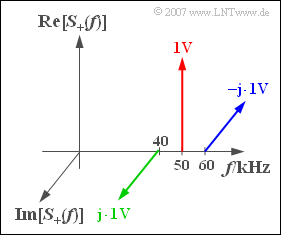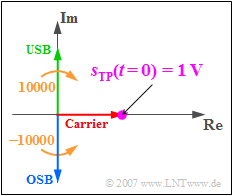Difference between revisions of "Aufgaben:Exercise 4.5: Locality Curve for DSB-AM"
m (Guenter moved page Exercise 4.5: Locus Curve for DSB-AM to Exercise 4.5: Locality Curve for DSB-AM) |
|||
| Line 1: | Line 1: | ||
| − | {{quiz-Header|Buchseite=Signal_Representation/ | + | {{quiz-Header|Buchseite=Signal_Representation/Equivalent_Low_Pass_Signal_and_its_Spectral_Function |
}} | }} | ||
Revision as of 15:16, 11 May 2021
We consider a similar transmission scenario as in task 4.4 (but not the same):
- a sinusoidal message signal with amplitude $A_{\rm N} = 2 \ \text{V}$ and the frequency $f_{\rm N} = 10 \ \text{kHz}$,
- DSB-Amplitude Modulation without carrier suppression with carrier frequency $f_{\rm T} = 50 \ \text{kHz}$.
Opposite you see the spectral function $S_+(f)$ of the analytical signal $s_+(t)$.
When solving, take into account that the equivalent low-pass signal is also in the form
- $$s_{\rm TP}(t) = a(t) \cdot {\rm e}^{{\rm j}\hspace{0.05cm}\cdot \hspace{0.05cm} \phi(t)} $$
where $a(t) ≥ 0$ shall hold. For $\phi(t)$ , the range of values $–\pi < \phi(t) \leq +\pi$ is permissible and the generally valid equation applies:
- $$\phi(t)= {\rm arctan} \hspace{0.1cm}\frac{{\rm Im}\big[s_{\rm TP}(t)\big]}{{\rm Re}\big[s_{\rm TP}(t)\big]}.$$
Hints:
- This exercise belongs to the chapter Equivalent Low-Pass Signal and Its Spectral Function.
- You can check your solution with the interactive applet Physical signal & equivalent LP signal ⇒ „locus curve”.
Questions
Solution
(1) If all diraclines are shifted to the left by $f_{\rm C} = 50 \ \text{kHz}$ , they are located at $-\hspace{-0.08cm}10 \ \text{kHz}$, $0$ and $+10 \ \text{kHz}$.
- The equation for $s_{\rm TP}(t)$ is with $\omega_{10} = 2 \pi \cdot 10 \ \text{kHz}$:
- $$s_{\rm TP}(t) = {\rm 1 \hspace{0.05cm} V} - {\rm j}\cdot {\rm 1 \hspace{0.05cm} V} \cdot {\rm e}^{{\rm j}\hspace{0.05cm} \omega_{\rm 10} \hspace{0.05cm} t }+{\rm j}\cdot {\rm 1 \hspace{0.05cm} V} \cdot {\rm e}^{-{\rm j}\hspace{0.05cm} \omega_{\rm 10} \hspace{0.05cm} t }$$
- $$\Rightarrow \hspace{0.3cm} s_{\rm TP}(t = 0) = {\rm 1 \hspace{0.05cm} V} - {\rm j}\cdot {\rm 1 \hspace{0.05cm} V} +{\rm j}\cdot {\rm 1 \hspace{0.05cm} V}= {\rm 1 \hspace{0.05cm} V}.$$
- $$\Rightarrow \hspace{0.3cm} {\rm Re}[s_{\rm TP}(t = 0) ] \hspace{0.15 cm}\underline{= {+\rm 1 \hspace{0.05cm} V}}, \hspace{0.2cm}{\rm Im}[s_{\rm TP}(t = 0) ] \hspace{0.15 cm}\underline{= 0} .$$
(2) The above equation can be transformed according to Euler's theorem with $T_0 = 1/f_{\rm N} = 100 \ {\rm µ} \text{s}$ as follows:
- $$\frac{s_{\rm TP}(t)}{{\rm 1 \hspace{0.05cm} V}}\hspace{-0.05cm} =\hspace{-0.05cm}1\hspace{-0.05cm} - \hspace{-0.05cm}{\rm j}\cdot \cos({ \omega_{\rm 10}\hspace{0.05cm} t }) \hspace{-0.05cm}+\hspace{-0.05cm} \sin({ \omega_{\rm 10}\hspace{0.05cm} t }) \hspace{-0.05cm}+\hspace{-0.05cm}{\rm j}\cdot \cos({ \omega_{\rm 10}\hspace{0.05cm} t })\hspace{-0.05cm} + \hspace{-0.05cm} \sin({ \omega_{\rm 10}\hspace{0.05cm} t }) = 1+2 \cdot \sin(2 \pi {t}/{T_0}) .$$
- This shows that $s_{\rm TP}(t)$ is real for all times $t$  .
- For the numerical values we are looking for, we obtain:
- $$s_{\rm TP}(t = {\rm 10 \hspace{0.1cm} {\rm µ} s}) = {\rm 1 \hspace{0.05cm} V} \cdot \left[1+2 \cdot \sin(36^\circ)\right]\hspace{0.15 cm}\underline{={{\rm +2.176 \hspace{0.05cm} V}}},$$
- $$s_{\rm TP}(t = {\rm 25 \hspace{0.1cm} {\rm µ} s}) = {\rm 1 \hspace{0.05cm} V} \cdot \left[1+2 \cdot \sin(90^\circ)\right]\hspace{0.15 cm}\underline{={{\rm +3 \hspace{0.05cm} V}}},$$
- $$s_{\rm TP}(t = {\rm 75 \hspace{0.1cm} {\rm µ} s}) = {\rm 1 \hspace{0.05cm} V} \cdot \left[1+2 \cdot \sin(270^\circ)\right]\hspace{0.15 cm}\underline{= -{{\rm 1 \hspace{0.05cm} V}}},$$
- $$s_{\rm TP}(t = {\rm 100 \hspace{0.1cm}{\rm µ} s}) = s_{\rm TP}(t = 0) \hspace{0.15 cm}\underline{={{\rm +1 \hspace{0.05cm} V}}}.$$
(3) By definition, $a(t) = |s_{\rm TP}(t)|$. This gives the following numerical values:
- $$a(t = {\rm 25 \hspace{0.1cm} {\rm µ} s}) = s_{\rm TP}(t = {\rm 25 \hspace{0.05cm}{\rm µ} s}) \hspace{0.15 cm}\underline{= {\rm +3 \hspace{0.05cm} V}} , \hspace{4.15 cm}$$
- $$a(t = {\rm 75 \hspace{0.1cm} {\rm µ} s}) = |s_{\rm TP}(t = {\rm 75 \hspace{0.05cm} {\rm µ} s})| \hspace{0.15 cm}\underline{= {\rm +1 \hspace{0.05cm} V}} .$$
(4) In general, the phase function is:
- $$\phi(t)= {\rm arc} \left[s_{\rm TP}(t)\right]= {\rm arctan} \hspace{0.1cm}\frac{{\rm Im}\left[s_{\rm TP}(t)\right]}{{\rm Re}\left[s_{\rm TP}(t)\right]}$$
Due to the fact that here ${\rm Im}[s_{\rm TP}(t)] = 0$ for all times, one obtains the result from this:
- If ${\rm Re}[s_{\rm TP}(t)] > 0$ holds, the phase $\phi(t) = 0$.
- On the other hand, if the real part is negative: $\phi(t) = \pi$.
We restrict ourselves here to the time range of one period: $0 \leq t \leq T_0$.
- In the range between $t_1$ and $t_2$ there is a phase of $180^\circ$ otherwise $\text{Re}[s_{\rm TP}(t)] \geq 0$.
- To calculate $t_1$ , the result of subtask (2) can be used:
- $$\sin(2 \pi \cdot {t_1}/{T_0}) = -0.5 \hspace{0.3cm} \Rightarrow \hspace{0.3cm} 2 \pi \cdot {t_1}/{T_0} = 2 \pi \cdot {7}/{12}\hspace{0.3cm}{\rm (corresponds to}\hspace{0.2cm}210^\circ )$$
- From this one obtains $t_1 = 7/12 · T_0 = 58.33 \ {\rm µ} \text{s}$.
- By similar reasoning one arrives at the result: $t_2 = 11/12 · T_0 = 91.63 \ {\rm µ} \text{s}$.
The values we are looking for are therefore:
- $$\phi(t = 25 \ {\rm µ} \text{s}) \; \underline { = 0},$$
- $$\phi(t = 75 \ {\rm µ} \text{s}) \; \underline { = 180^{\circ}}\; (= \pi).$$

